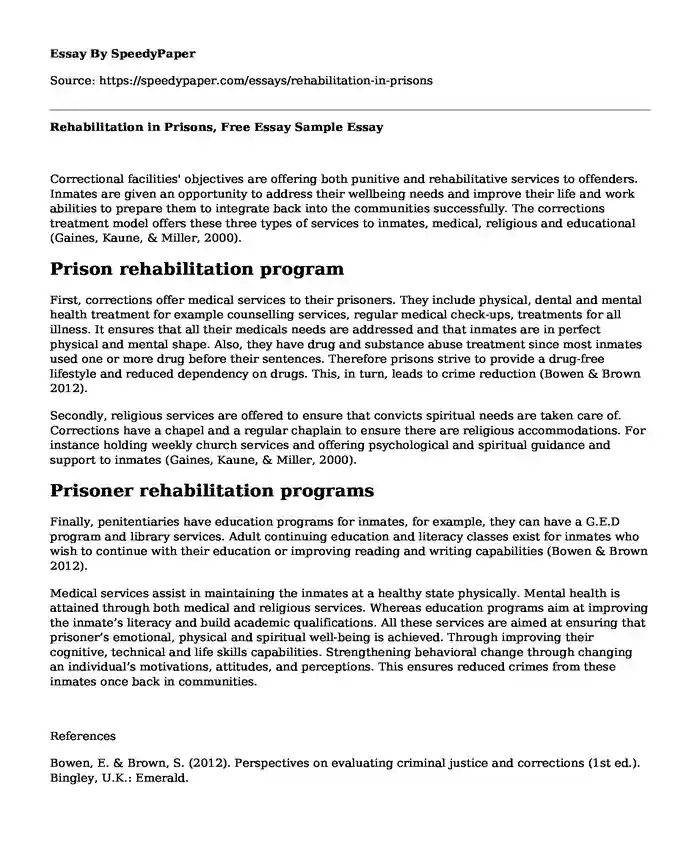
| Type of paper: | Essay |
| Categories: | Health and Social Care Punishment Criminal justice |
| Pages: | 2 |
| Wordcount: | 373 words |
Correctional facilities' objectives are offering both punitive and rehabilitative services to offenders. Inmates are given an opportunity to address their wellbeing needs and improve their life and work abilities to prepare them to integrate back into the communities successfully. The corrections treatment model offers these three types of services to inmates, medical, religious and educational (Gaines, Kaune, & Miller, 2000).
Prison rehabilitation program
First, corrections offer medical services to their prisoners. They include physical, dental and mental health treatment for example counselling services, regular medical check-ups, treatments for all illness. It ensures that all their medicals needs are addressed and that inmates are in perfect physical and mental shape. Also, they have drug and substance abuse treatment since most inmates used one or more drug before their sentences. Therefore prisons strive to provide a drug-free lifestyle and reduced dependency on drugs. This, in turn, leads to crime reduction (Bowen & Brown 2012).
Secondly, religious services are offered to ensure that convicts spiritual needs are taken care of. Corrections have a chapel and a regular chaplain to ensure there are religious accommodations. For instance holding weekly church services and offering psychological and spiritual guidance and support to inmates (Gaines, Kaune, & Miller, 2000).
Prisoner rehabilitation programs
Finally, penitentiaries have education programs for inmates, for example, they can have a G.E.D program and library services. Adult continuing education and literacy classes exist for inmates who wish to continue with their education or improving reading and writing capabilities (Bowen & Brown 2012).
Medical services assist in maintaining the inmates at a healthy state physically. Mental health is attained through both medical and religious services. Whereas education programs aim at improving the inmate’s literacy and build academic qualifications. All these services are aimed at ensuring that prisoner’s emotional, physical and spiritual well-being is achieved. Through improving their cognitive, technical and life skills capabilities. Strengthening behavioral change through changing an individual’s motivations, attitudes, and perceptions. This ensures reduced crimes from these inmates once back in communities.
References
Bowen, E. & Brown, S. (2012). Perspectives on evaluating criminal justice and corrections (1st ed.). Bingley, U.K.: Emerald.
Gaines, L., Kaune, M., & Miller, R. (2000). Criminal justice in action (1st ed.). Belmont, CA: Wadsworth/Thomson Learning.
Cite this page
Rehabilitation in Prisons, Free Essay Sample. (2017, Dec 28). Retrieved from https://speedypaper.net/essays/rehabilitation-in-prisons
Request Removal
If you are the original author of this essay and no longer wish to have it published on the SpeedyPaper website, please click below to request its removal:
- Essay Example on the Re-make Myer's Stufy / Quasi Experiment
- The Mexican War Essay Sample
- Research Proposal Paper Sample: Implementation Plan for Evidence-Based Practice
- Free Essay Focusing on Confidentiality in Group Therapy
- SWOT Analysis of IRM
- Free Essay: Pesticide - Environmental Concern
- Free Essay Sample: Human Resource Issues.
Popular categories




